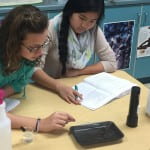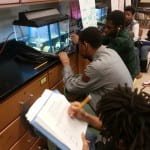Environmental health science is a critical part of our daily lives and affects everyone in many ways. The goal of the UWM WInSTEP SEPA program is to provide middle and high school science students with multiple, integrated opportunities to conduct inquiry-based experiments that link biological concepts with environmental health issues. Specifically, students study the effects of various environmental agents on zebrafish embryo development, earthworm behavior, fathead minnow reproductive behavior, and learning and memory which serve as models for human health effects.
The Nerve and Muscular Basis of Earthworm Movements: Effects of Physical and Chemical Environmental Agents
 This module provides students with the opportunity to study controlled neuromuscular activity in the earthworm, and then to make comparisons with worms exposed to various environmental agents. Through the study of simple reflexes in earthworms and the impact environmental agents have on these behaviors, students learn about concepts pertaining to living organisms including structure, function, regulation, behavior, science and technology. They use skills in scientific processes and reasoning as they generate and clarify questions, conduct investigations, analyze data, and make critical connections between evidence and explanation. They articulate their own questions about animal behaviors, and their susceptibility to environmental agents. Students interpret data to draw conclusions and generate explanations and propose hypotheses that link their personal health to environmental agents.
This module provides students with the opportunity to study controlled neuromuscular activity in the earthworm, and then to make comparisons with worms exposed to various environmental agents. Through the study of simple reflexes in earthworms and the impact environmental agents have on these behaviors, students learn about concepts pertaining to living organisms including structure, function, regulation, behavior, science and technology. They use skills in scientific processes and reasoning as they generate and clarify questions, conduct investigations, analyze data, and make critical connections between evidence and explanation. They articulate their own questions about animal behaviors, and their susceptibility to environmental agents. Students interpret data to draw conclusions and generate explanations and propose hypotheses that link their personal health to environmental agents.
Zebrafish as Models: Studying the Effects of Environmental Agents on Human Health
![Zebrafish 025[1]](https://sites.uwm.edu/winstep/files/2016/06/Zebrafish-0251-ty0zrb-150x150.jpg) Using zebrafish embryos exposed to various environmental toxicants such as ethanol, nicotine, and caffeine, students examine the general development of zebrafish embryos and malformations that occur. By applying the results of the zebrafish embryo experiments to human embryo development, students draw conclusions regarding personal health, environmental hazards, and the risks and benefits of personal and social decisions in relation to these hazards. Students also gain insight into science as a human endeavor, one that serves to characterize the impact of human action on environments and the impact of the environment on human health.
Using zebrafish embryos exposed to various environmental toxicants such as ethanol, nicotine, and caffeine, students examine the general development of zebrafish embryos and malformations that occur. By applying the results of the zebrafish embryo experiments to human embryo development, students draw conclusions regarding personal health, environmental hazards, and the risks and benefits of personal and social decisions in relation to these hazards. Students also gain insight into science as a human endeavor, one that serves to characterize the impact of human action on environments and the impact of the environment on human health.
Integrating Physiology and Behavior: Using Fathead Minnows to Model the Effects of Environmental Agents
 This module is a hands-on investigation of the effect of lead on fathead minnow reproductive behaviors. Students observe normal and abnormal breeding behaviors of both male and female fathead minnows, a fish native to Wisconsin and often used for environmental toxicity tests. Using a video-format experiment, students compare the effects of lead to mercury. In addition, students learn how changes in these behaviors are related to changes in fish physiology due to exposure to lead. Importantly, students also learn the efficacy of different methods of reducing lead exposure. Lastly, students see the effects of embryonic exposure to lead on embryo growth and larval behavior. All this is then compared to what happens to humans exposed to lead or mercury, i.e., how are fish models of human environmental health.
This module is a hands-on investigation of the effect of lead on fathead minnow reproductive behaviors. Students observe normal and abnormal breeding behaviors of both male and female fathead minnows, a fish native to Wisconsin and often used for environmental toxicity tests. Using a video-format experiment, students compare the effects of lead to mercury. In addition, students learn how changes in these behaviors are related to changes in fish physiology due to exposure to lead. Importantly, students also learn the efficacy of different methods of reducing lead exposure. Lastly, students see the effects of embryonic exposure to lead on embryo growth and larval behavior. All this is then compared to what happens to humans exposed to lead or mercury, i.e., how are fish models of human environmental health.
Effects of Toxic Chemicals on Learning and Memory: Using Fish as a Model for Human Environmental Health
 Through the study of learning and memory in multiple fish species, students learn the basic concepts and principles of living organisms, including structure and function, regulation and behavior, and populations and ecosystems. Specifically, students use live fish to understand normal learning abilities and explore possible effects of environmental agents on learning. Through an inquiry-based approach, students articulate and refine their own broad questions about learning and memory, and the environmental variables that may affect these processes. Students propose hypotheses that link their personal health to environmental hazards which will ultimately help in personal and social decision-making.
Through the study of learning and memory in multiple fish species, students learn the basic concepts and principles of living organisms, including structure and function, regulation and behavior, and populations and ecosystems. Specifically, students use live fish to understand normal learning abilities and explore possible effects of environmental agents on learning. Through an inquiry-based approach, students articulate and refine their own broad questions about learning and memory, and the environmental variables that may affect these processes. Students propose hypotheses that link their personal health to environmental hazards which will ultimately help in personal and social decision-making.